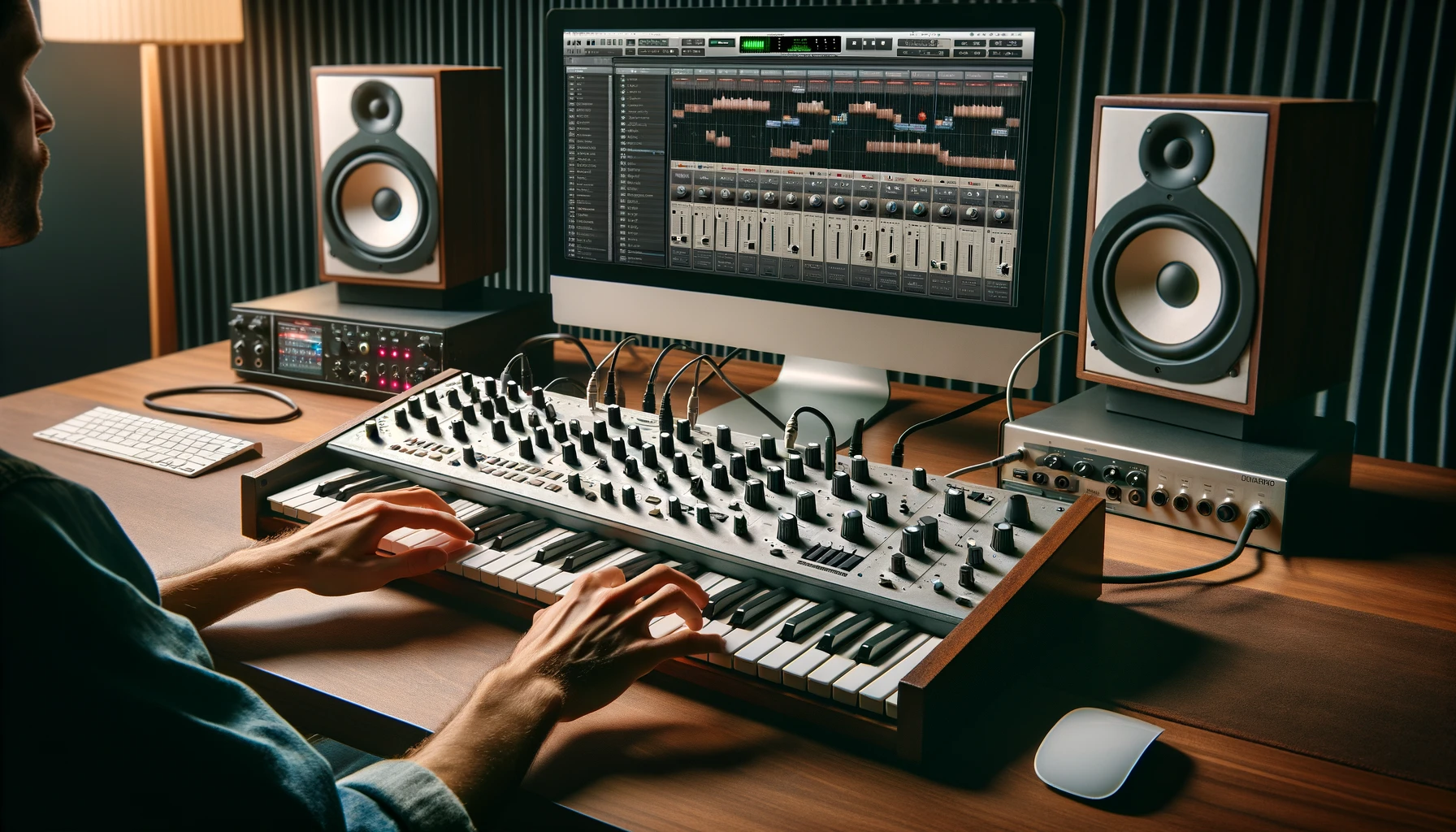Have you ever wondered if you can use your old hardware synthesizer as a MIDI controller? With the rise of virtual instruments and MIDI technology, those classic synth keyboards, keybeds, and control panels can enjoy a renewed purpose.
Let’s explore how to leverage that beloved analog to control software devices via MIDI for ultimate sound design flexibility.
This guide covers everything from understanding MIDI basics to specific considerations when repurposing a synthesizer as a versatile MIDI controller.
So scroll down to learn how MIDI can breathe new creative life into your hardware synth interface…
Can You Use a Synthesizer as a MIDI Controller?
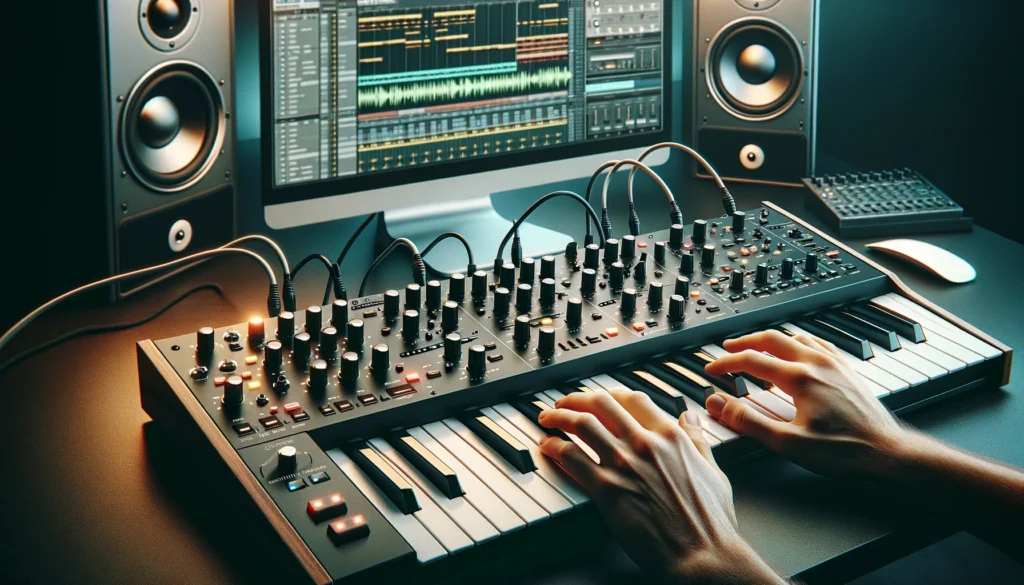
Yes, you absolutely can utilize a synthesizer as a MIDI controller to transmit performance data from the hardware interface to control parameters on external MIDI gear and software instruments.
By connecting your synth via MIDI cables and setting transmit/receive channels to match the target devices, those tactile knobs, keys, ribbons, and buttons essentially convert into a powerful MIDI control surface.
The synth keyboard, for example, will trigger notes on downstream sound modules and virtual instruments instead of only playing the synthesizer’s internal tones.
The synth still creates its native sounds, but now also serves as the portal for playing and manipulating additional connected MIDI equipment too.
Let’s get into more details throughout this guide.
What is a Synthesizer?
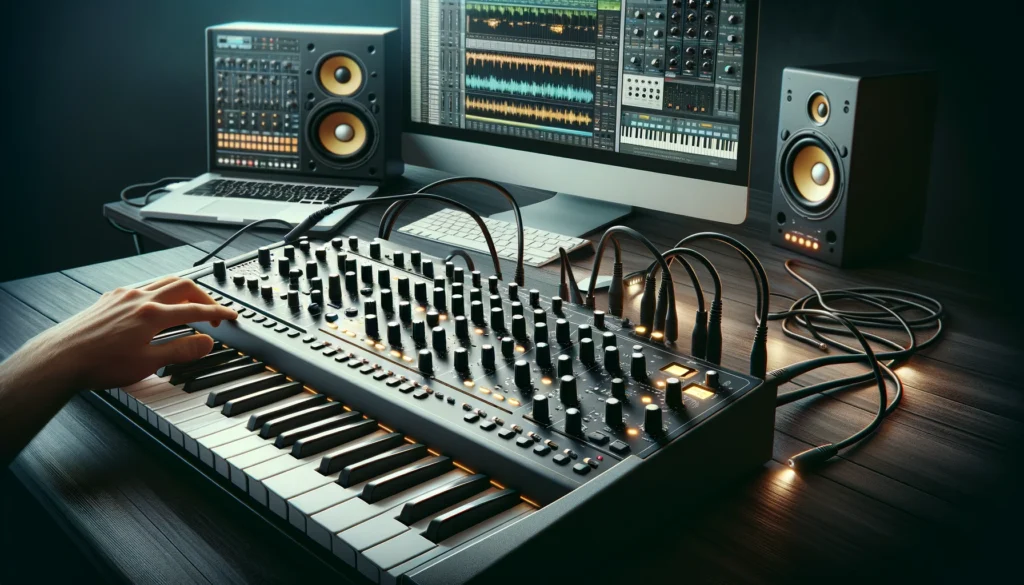
A synthesizer (also known as a synth) is an electronic musical instrument that generates audio signals.
Synthesizers use oscillators, filters, amplifiers, envelope controllers, and various other mechanisms to create different sounds and effects.
There are many types of synthesizers, such as analog, digital, software, and modular synths, and they are common in many genres of music.
Synthesizers can produce an incredible range of sounds – from imitating real instruments like pianos and guitars to creating entirely unique timbres.
A well-programmed synth can sound like just about anything.
Some key features of most synthesizers are multiple oscillators that produce the raw tones, filters that shape the timbre, low frequency oscillators (LFOs) that produce modulation effects, envelope generators that control amplitude and filter changes over time, and amplifiers and effects units that further customize the final sound.
Synthesizers usually have keyboards as the main controllers but can also be played using other controllers like MIDI guitar pickups, electronic drum pads, or ribbon controllers.
The techniques for playing a synthesizer are similar to those for keyboard instruments but offer more flexible options for altering sounds while playing.
What is MIDI?
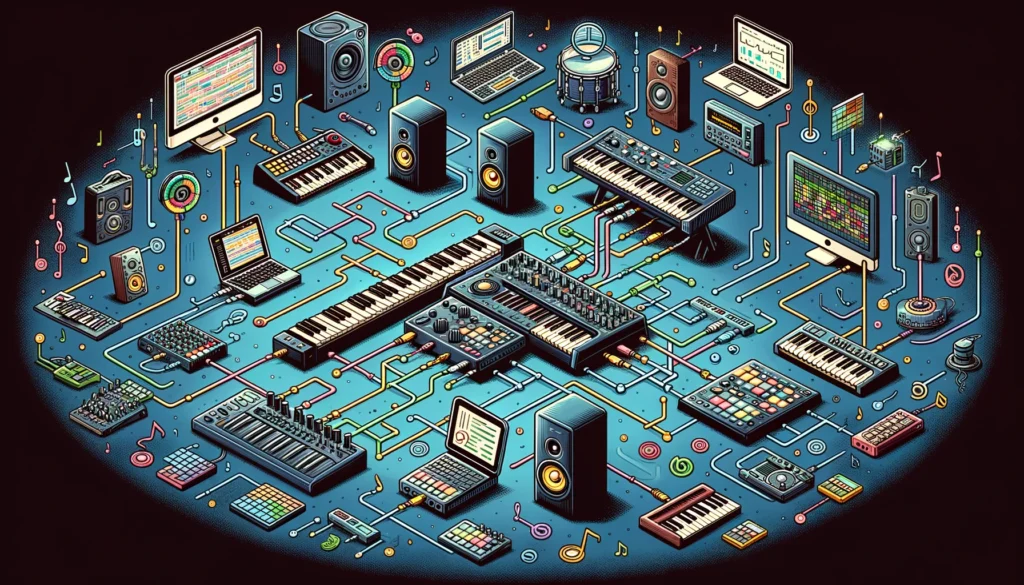
MIDI (Musical Instrument Digital Interface) is an important communication protocol that allows musical instruments, computers, and other MIDI devices to connect with each other and exchange performance data.
The most common MIDI messages include note on/off events (which note to play/stop and the velocity or intensity), continuous controller data like pitch bend or modulation, program change messages to select sounds or patches, and synchronization data to allow MIDI instruments to play together in rhythm.
MIDI data is transmitted over MIDI cables or via wireless Bluetooth MIDI.
Unlike audio signals, MIDI data does not transmit actual sound – rather, it transmits digital messages that instruments and devices can interpret as musical performances and audio processing instructions.
This means MIDI data requires much less bandwidth than audio.
MIDI enabled devices read this performance information and use their own sounds and parameters to play audio based on the MIDI messages received.
This makes it easy to simultaneously control multiple instruments from a central MIDI controller.
Common applications of MIDI connectivity include recording software, hardware synths/samplers, MIDI guitars and drums, show control systems, and more.
Connecting a Synthesizer via MIDI
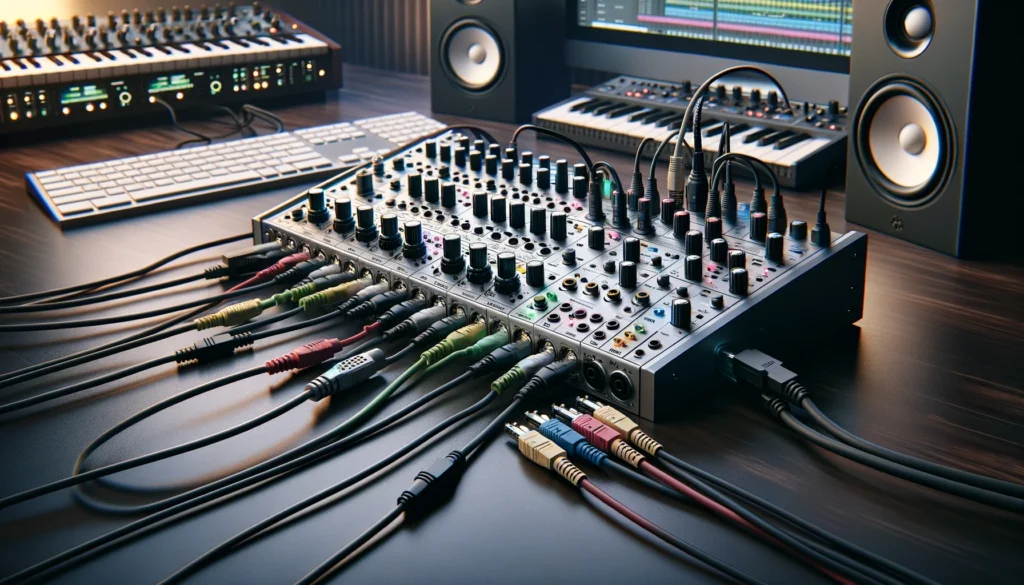
Most synthesizers come equipped with standard MIDI ports that enable connection with other MIDI equipment.
The 5-pin DIN connectors transmit and receive MIDI data to interface with computers, MIDI interfaces, MIDI patch bays, and additional synths/devices.
There are two main types of ports – MIDI In and MIDI Out.
MIDI Out transmits MIDI data from the synthesizer.
MIDI In receives MIDI data being sent to the synth from an external source.
Some synths also have a MIDI Thru port that duplicates everything received at the MIDI In port and passes it along unchanged.
This allows for daisy chaining multiple devices together.
By connecting a synth to MIDI compatible devices, it enables the synth to both send and react to MIDI control messages.
The synth can now be used to trigger notes and manipulate parameters on external MIDI gear.
Most synthesizers utilize DIN MIDI ports, but some modern synths also offer USB-MIDI connections to directly interface with computers.
Once connected via MIDI, a synthesizer can be integrated into a flexible MIDI environment for recording, effects, live performance, and more.
The MIDI connection turns the synthesizer into a versatile MIDI controller by harnessing the MIDI protocol.
Using a Synth as a MIDI Controller
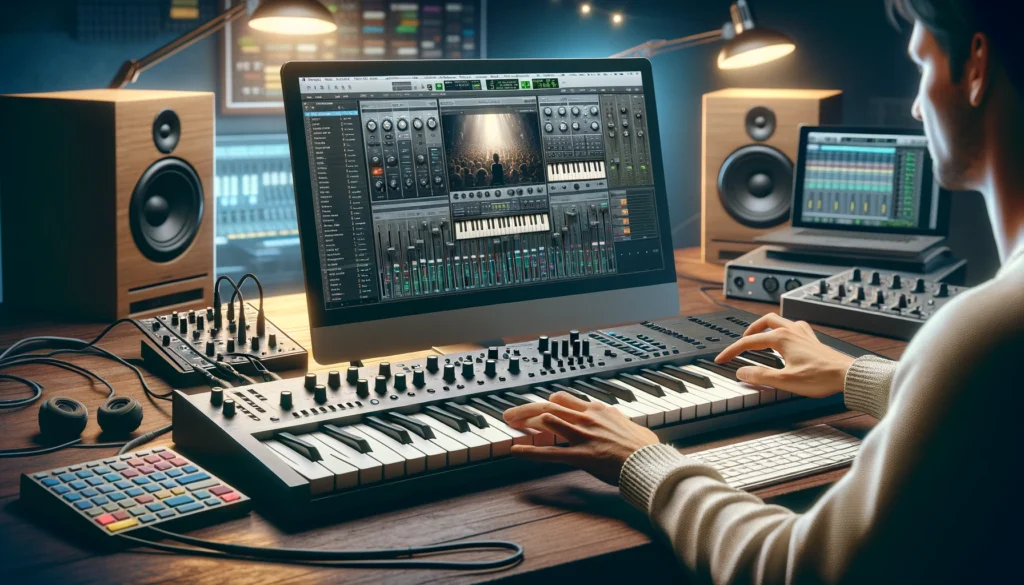
By connecting a synthesizer to other MIDI devices, the synth can then be used as a MIDI controller.
This allows the keys, knobs, buttons, and other controls on the synth to transmit MIDI data to external modules and computer software.
The physical playing controls on a synth essentially become a versatile interface for controlling virtual instruments, samplers, drum machines, DAWs, and more.
For example, playing the keys on a synth with a MIDI connection will transmit note on/off messages over MIDI instead of only playing the synth’s internal sounds.
This note data could be sent to software synthesizers and samplers on a computer, enabling the synth keyboard to now play those virtual instrument sounds.
The same concept applies for other synth controls like pitch/mod wheels, sustain pedals, or sequencer controls which can manipulate parameters on MIDI connected devices during or after playing the controller keyboard.
Simultaneously, the synthesizer can still utilize its own onboard voices.
This provides ultimate flexibility – playing the keyboard normally to sound the internal synth tones while also leveraging the physical interface to control an array of external MIDI gear.
Using a synth keyboard for MIDI input offers richer expression thanks to aftertouch, key pressure, control configurations, and other benefits.
Benefits of Using a Synth as a Controller
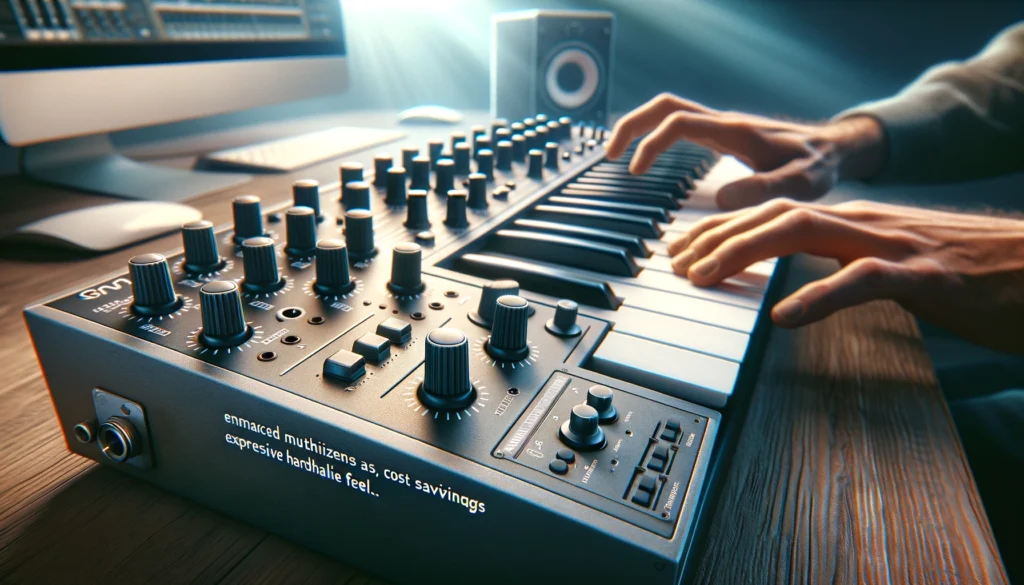
There are many advantages to utilizing the hands-on control features of a hardware synthesizer as a MIDI controller:
Cost Savings – Using a synth’s existing keyboard, knobs, and buttons as a MIDI controller is significantly cheaper than buying separate MIDI keyboards and controllers.
The sounds themselves are produced elsewhere, allowing you to save money by just investing in the synth controls.
Utilize Feature-Rich Keybeds – Many synths (especially vintage ones) have high-quality keyboards with velocity/aftertouch, which provide expressive control that rivals more expensive MIDI controllers.
Why not get double value out of them?
Change Sounds Easily – By simply changing patch presets on your MIDI sound module or DAW, you can totally alter the sound being played from your synth keyboard without having to modify any synth parameters.
Hardware Control Feel – The hands-on tactile control of real buttons, knobs, and keyboards provides a different experience than using virtual controls and gestures on controllers lacking physical parameters.
Various Integration Options – With MIDI routing, old and new-generation synths alike integrate with software and external MIDI gear for flexible studio and stage signal flows involving composition, patch organization, effects, recording, and live performance scenarios.
Setup Considerations
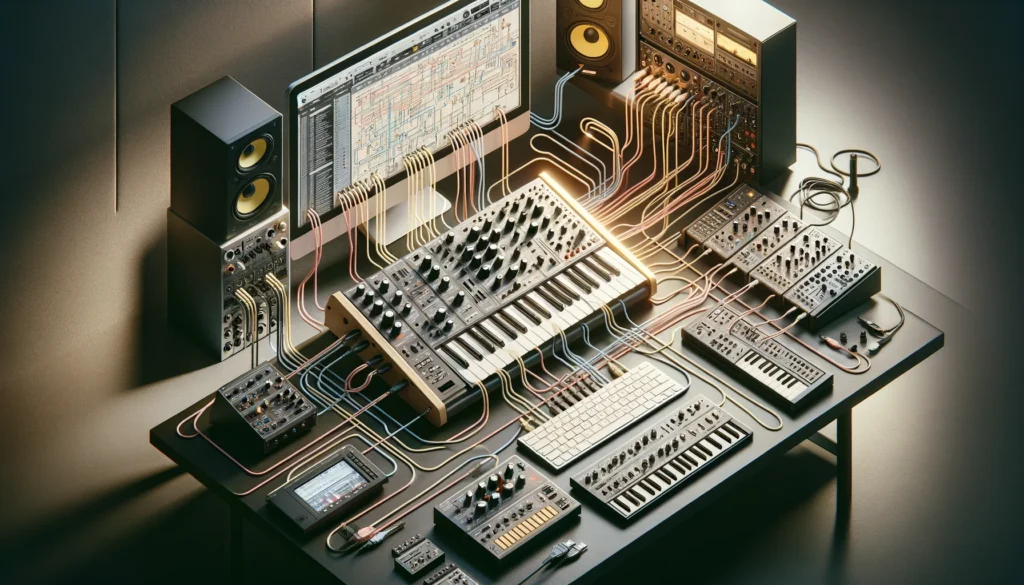
Properly setting up a synthesizer as a MIDI controller requires some connectivity considerations and software settings.
Here are a few key things to address when using a synth to control external MIDI devices:
MIDI Routing – Physical MIDI cables or a USB-MIDI interface need to connect the synthesizer to target device(s) it will be controlling.
Check that MIDI transmit channels match device receive channels.
Control Mapping – The synth’s controls like keys, wheels, buttons need mapped to specific functions for the target device like notes, CCs, program changes etc.
Many devices and DAWs feature MIDI mapping to assign controls to parameters.
Multi-Timbral Operation – If connecting to keyboards/modules or software instruments, check they support multi-timbral mode.
This allows simultaneous control of multiple sound engines from the synth controller interface by accessing different MIDI channels.
Performance Controls – Leveraging aftertouch and velocity sensitivity when available for expressive playing dynamics.
Consider unlatching delay effect holds for real-time tweakability.
Output Configuration – For using synth as both controller while also hearing its onboard sounds, utilize multiple MIDI Thru boxes and audio outputs to feed both the synth module and MIDI gear being controlled.
By addressing these setup elements, your synth will integrate with your other MIDI gear for seamless control capabilities and strengthened performance expressiveness overall! Let me know if any part needs more explanation.
Conclusion
In summary, connecting synthesizers via MIDI opens powerful creative possibilities for sound design and performance flexibility.
Whether utilizing vintage analog synths or modern hardware, interfacing these instruments with MIDI compatibility allows you to leverage that keybed, faders, pads as a control interface for external devices.
With some connectivity and routing considerations covered here, your classic synthesizer can speak MIDI – unlocking new dimensions for composition, production, and live play.
